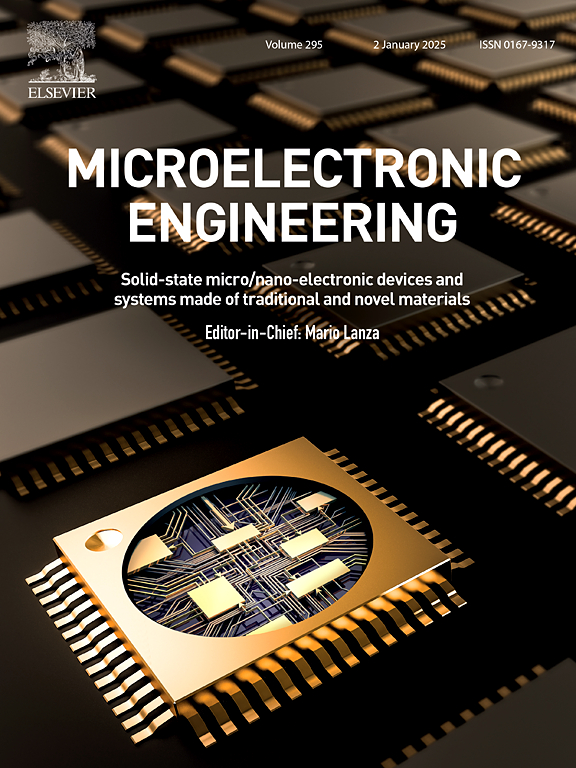基于Ti和ni的BEOL cmos兼容P+-InGaAs欧姆触点,用于未来的无线通信
IF 3.1
4区 工程技术
Q2 ENGINEERING, ELECTRICAL & ELECTRONIC
引用次数: 0
摘要
我们报告了在200 mm Si衬底上集成了具有cmos兼容流的缩放Ti和ni基P+-InGaAs (:C)欧姆触点的电学结果。为了评估接触性能和热稳定性,首先在快速热退火(RTA)后进行了传递长度法(TLM)测量。目标温度与典型的Si-CMOS后端线(BEOL)热预算有关。然后强调了在cmos兼容过程中由于InGaAs层的氢暴露而导致的受体钝化问题。接触腔的腐蚀被认为是根本原因。最后,采用先前开发的基于tlm的数值提取方法,实现更精确的电阻率参数评估。从缩放后的ti基和ni基触点中分别提取出5 × 10−7和3 × 10−6 Ω*cm2的比接触电阻率值。5 × 10−7 Ω*cm2值接近异质结双极晶体管(HBT)中基极接触所需的10−8 Ω*cm2量级,以达到太赫兹性能,这对于未来的6G/亚毫米波(sub-mmW)应用至关重要。本文章由计算机程序翻译,如有差异,请以英文原文为准。

Ti and Ni-based BEOL CMOS-compatible P+-InGaAs ohmic contacts for the future of wireless communications
We report the electrical results of scaled Ti and Ni-based P+-InGaAs (:C) ohmic contacts integrated with a CMOS-compatible flow on 200 mm Si substrates. To evaluate contact performance as well as thermal stability, Transfer Length Method (TLM) measurements were first conducted after rapid thermal annealing (RTA). The targeted temperatures are relevant to the typical Si-CMOS Back End Of Line (BEOL) thermal budgets. The issue of acceptor passivation, resulting from hydrogen exposure of the InGaAs layer during CMOS-compatible process, is then emphasized. The etching of the contact cavities was identified as being the root cause. Finally, a previously developed TLM-based numerical extraction method was employed to achieve a more precise assessment of the resistivity parameters. Specific contact resistivity values as low as 5 × 10−7 and 3 × 10−6 Ω*cm2 were respectively extracted from scaled Ti-based and Ni-based contacts. The 5 × 10−7 Ω*cm2 value approaches the required magnitude of 10−8 Ω*cm2 for the base contact in a Heterojunction Bipolar Transistor (HBT) in order to reach THz performance, which is crucial for future 6G/sub-millimeter Wave (sub-mmW) applications.
求助全文
通过发布文献求助,成功后即可免费获取论文全文。
去求助
来源期刊

Microelectronic Engineering
工程技术-工程:电子与电气
CiteScore
5.30
自引率
4.30%
发文量
131
审稿时长
29 days
期刊介绍:
Microelectronic Engineering is the premier nanoprocessing, and nanotechnology journal focusing on fabrication of electronic, photonic, bioelectronic, electromechanic and fluidic devices and systems, and their applications in the broad areas of electronics, photonics, energy, life sciences, and environment. It covers also the expanding interdisciplinary field of "more than Moore" and "beyond Moore" integrated nanoelectronics / photonics and micro-/nano-/bio-systems. Through its unique mixture of peer-reviewed articles, reviews, accelerated publications, short and Technical notes, and the latest research news on key developments, Microelectronic Engineering provides comprehensive coverage of this exciting, interdisciplinary and dynamic new field for researchers in academia and professionals in industry.
 求助内容:
求助内容: 应助结果提醒方式:
应助结果提醒方式:


